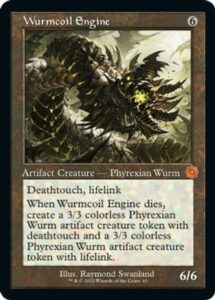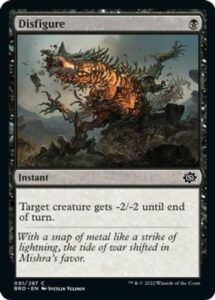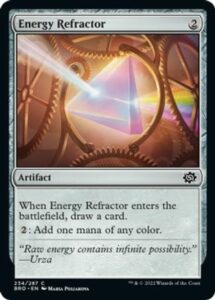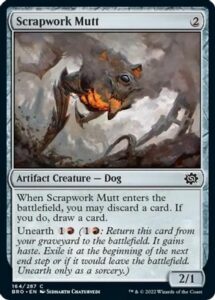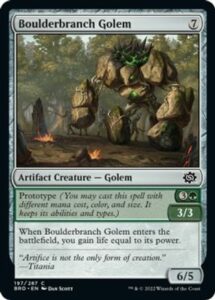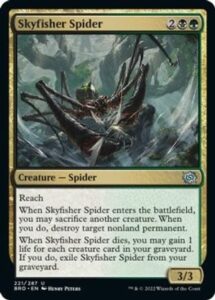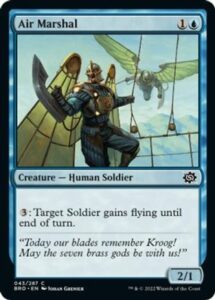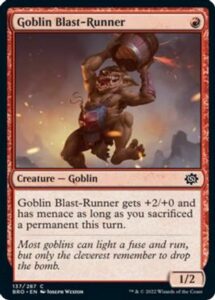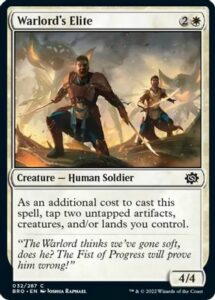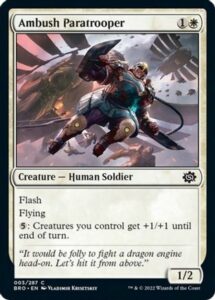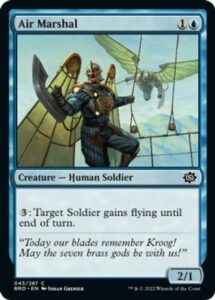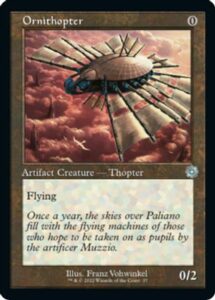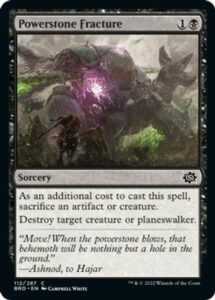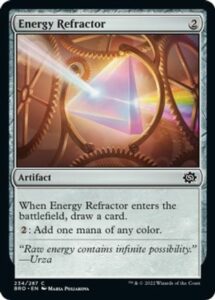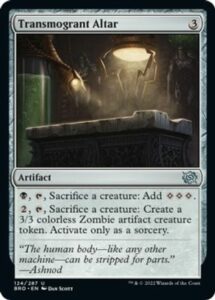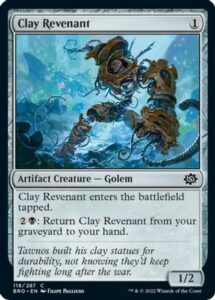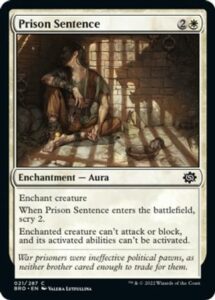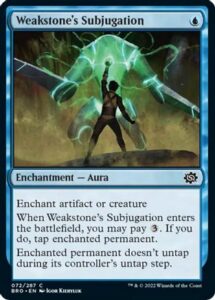Brothers’ War Limited

This past weekend was the Arena Open. Limited was featured again, and this time, the focus was on Brother’s Limited. I’ve been slow to write about Brother’s War Limited, but it’s about time I do.
There are a few more upcoming events, such as the Arena Championship Qualifier and some MOCS stuff, so it’s not too late. I plan to play as much of these as I can.
Brother’s War, the “Transformers set,” was designed with that concept in mind, but ultimately it misses a bit on giant robots battling it out. The prototype cards that aren’t in the rare or mythic category are all underwhelming. While playable, the format isn’t about making the most gigantic creature. Like most Limited formats, it’s important to get on the board early, push advantages, and set up some synergies.
Removal/Combat Tricks

Your choices for removal are to get a decent amount of it or to have a linear proactive game plan that implements combat tricks. Combat tricks are reasonably pushed for Limited. Giant Growth isn’t even the best green combat trick with Gaea’s Gift in the format.
With Retro Artifacts, or whatever their nomenclature is, running around, Disenchant effects are playable in the main deck. In fact, I’d say you’d like to have at least one way to remove an artifact from play in every deck like Disenchant or Shoot Down. They’re both solid cards you’d like a copy of to play. Raze to the Ground is playable, but I try to avoid it since it’s an expensive reactive card in a color that thrives on mana efficiency.
Curve Considerations/Speed

My initial assessment after the first draft or two was wildly off. The format isn’t very slow. In fact, it’s generally tempo-oriented but can slow to a crawl in some cases.
It’s important to draft efficient spells rather than spells with a huge mana investment. For instance, while Wurmcoil Engine is one of the best cards in the format, it’s easily answered with a card like Shoot Down and Overwhelming Remorse at common. The same is true for some less impactful bombs like Helm of the Host, Phyrexian Process, Staff of Domination, and Platinum Angel. There’s efficient removal for all of them, and they require huge mana investments. This is a bad combination in a format that can punish you for stumbling.
Don’t get me wrong, I still take these cards early and aggressively, but they’re not carrying games as well as they may have in the past. The format is designed well and in a manner where you don’t just win if Wurmcoil Engine resolves.
In general, I think aiming for a low curve, synergy-based, aggro deck is optimal.
Do I Splash? What’s My Draft Strategy?

This is the hardest format (maybe ever?) where the question of splashing comes into play for me. I’ve been overall less greedy in this format because I get punished when I get greedy, but I also haven’t had much need to splash a lot.
My strategy for this format generally involves staying open for the first few picks if I don’t open a bomb. If I do, I generally dive in head first with blinders on. I bias my picks towards black, as I believe top-to-bottom at common has the most flexible and powerful cards. Disfigure, Powerstone Fracture, and Overwhelming Remorse at common, along with Gixian Infiltrator, make for a solid core to a deck.
Evolving Wilds, Energy Refractor, and cards like Chromatic Star and Elsewhere Flask enable splashes, but the benefit of staying open and selecting cards like this early and figuring out which archetype is open leads to less situations where I need to splash. If I’m heavily white, black, or red early, I try to stay that way as long as possible in case I get some of the mono-colored uncommon payoffs that lead to less third-color splashes.
For example, early in drafts when I’m seeing a pack with Chromatic Star and Prison Sentence in an otherwise weak pack, I generally just take Chromatic Star and see what develops. Prison Sentence, on the other hand, is a card I’m not in love with but is a solid playable removal spell.
I do splash unearth abilities. I don’t usually put actual basics in my deck to support unearth, but I will play a mountain if I have four Scrapwork Mutts or something. Rather, I make sure I play energy refractors and such that I might not otherwise play to support bringing back a pair of off-color Scrapwork Mutts, or in some cases, even prototype-light splashes like Boulderbranch Golem if you need a top-end threat and are splashing a Skyfisher Spider or something.
The Best Archetypes


I have diagnosed that my specific strategy does lend me to almost never ending up in one of the best if not the best archetypes, UW Soldiers.
UW Soldiers is the deck I lose to most. I don’t even identify any of my opponents’ specific cards as great, rather it can be hard to keep up with a curve of fliers and a card like Scrapwork Cohort gumming up the ground. Air Marshal has been more impressive than it looks as life totals go down in a hurry in this format and one or two activations can steal games quickly.
My go-to archetypes are Rakdos Sacrifice, Golgari Self-Mill, and UR Artifact and Spell. These are the three archetypes I have the most success playing.
Below are example trophy lists.


This is nuts-and-bolts Golgari Self-Mill with no broken rares. This is from one of the first days of the format. In retrospect, I’d not play Gix’s Caress in the main and would play Gaea’s Gift instead. I likely should add Thraxodemon and cut a land. Sixteen lands with a Bushhack and three Blanchwood Prowlers is fine. Below is a more recent GB deck built more optimally.




This is a bomb-filled Rakdos Sac deck. It’s easy to see why this one earned a trophy. It had solid removal and strong top-end rares.


This is one of the more fun decks I had the pleasure of piloting in this format. This deck was nothing but consistent with all the card filtering, which made it important that my cards were mostly cheap so that I could add to the battlefield and pick spots with my limited available removal. I was able to cast both of my removal spells in almost every game because I often got to the bottom of my deck in a hurry.


Lastly, here is my Mona Lisa. I have a thing for animating artifacts, and this deck did not disappoint. Mightstone Animation is one of the few commons you can build your deck around in high numbers, which there seems to be a few of in this format with cards like Goblin Blast-Runner, Giaxian Infiltrator, Warlord’s Elite, and Mightstone Animation.
You haven’t lived Limited until you’ve attacked someone with a Howling Mine to deprive them of the extra cards.
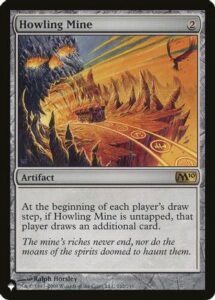
Underrated Cards
Lastly, I’ll point out some cards that are going too late from my personal experience.
White
Threat of activation, ability to ambush 1/1s, and playing well with instants makes Ambush Paratrooper a total package and one of the better white commons. I still wheel them regularly.
Warlord’s Elite can be an archetype if you’re able to pick up a couple in pack one. It allows you to make use of cards like Bone Saw as a mana rock and is strong if it’s the top of your curve, which you can make work in this format.
Blue
Air Marshal is the card that has killed me more than any other common in BRO. At least that’s what my memory is selecting for at the moment. While it’s not great early, it can get some cheap damage in or trade off early. It’s best at making cards like Scrapwork Cohort, itself, and Warlord’s Elite into flying clocks that end games quickly.
Mightstone Animation usually goes into a completely different style of deck, but it’s one of the highest impact commons in the format. If you’re able to pick up a few of them, you can draft cheap cantripping artifacts and cards that create powerstones and turn Mightstone Animation into its own archetype. A four-mana 4/4 haste is nothing to sneeze at, and there’s little additional support for leaning into an all-artifact strategy. While the card is excellent on its own, it’s really strong if you get three or four, as you can put cards like Ornithopter in your deck that you can get as late as last pick since it’s not really a card anyone wants.
Black
In a format that’s supposed to be about big robots, you’d think Disfigure wouldn’t be as important. However, it’s the best card we have for breaking up early raw, aggressive, powerful starts from small creatures that can grow like Giaxian Infiltrator, Argothian Sprite, and Goblin Blast-Runner.
While not the premium removal that Overwhelming Remorse is, it’s still close enough that I like to take them highly. Effects like this often have severe diminishing returns and generally Bonesplinters cards are fairly bad, but this one is the best it’s been in quite some time. The ability to sacrifice artifacts you have laying around and to get sacrifice synergy benefits from Giaxian Infiltrator and Goblin Blast-Runner make the downside more neutral. This card probably looks much better to me than others because I’m taking the flexible artifact cards early to enable getting cards like this later, and I’m still occasionally wheeling this one.
Red
I struggled with this one because there’s no card in red I think I’m getting later than I should, but there’s one surprising card I’ve liked a lot more as the format developed.
It’s a weird card to add to my list, but it’s been an incredible sideboard card for me. I bring it in against Wing Commando decks, and I’m happy to slow the air aggression down. I’m usually not happy to start this card with all the 1/1s running around, but it does apply pressure and can trade up defensively, so it’s a totally reasonable card despite it looking pretty bad.
Green
Satyr Wayfinder has a history of being undervalued and it continues. I often wheel this card. It’s one of the better green commons for me because I so often end up in black where a random 1/1 body and some self-mill are great. There are also a lot of X/1 creatures in this format, so a two-drop that slows down the opponent and nets you a card is a huge boon. On top of that, it leaves you that body to sacrifice to a Powerstone Fracture or Skyfisher Spider.
I’ve absolutely loved this card in basically all green archetypes. It filters mana with leftover Powerstones, with that Energy Refractor you played on turn two, or with whatever random piece of cardboard you have laying around. Loam Dryads have often been undervalued but this is the best this type of card has been. There’s so many more ways to enable it in this format, and it even has synergies with cards like Key to the City or Howling Mine.
I adore this two-drop. Occasionally, it has “unblockable” printed on it when someone is too far down the artifact creature hole, and the activated ability is far more than just flavor text in my experience. Two-drops are also quite important.
Artifact
I could argue that many artifacts are underrated because they’re colorless and staying flexible is good in this format, but instead I’ll just put one card I like a lot more than I thought I would on this list.
The Altar with Clay Revenant combo has been much better than I anticipated. Altar being used as a Worn Powerstone to ramp out some big bad robot has been useful, as well as turning random 1/1s into 3/3s and addressing creatures with cards like Prison Sentence or Weakstone Subjugation. It also provides value related to sacrifice matters, such as Gixian Infiltrator, and acts as an engine when games go long.
It’s more versatile than it looks, so I’ve always been happy to include a copy with a Clay Revenant in my black decks. Black also has the best chance of playing long, winning games against aggro decks with all of its removal.
Brother’s War Limited is a lot of fun, but the introduction of an additional slot that can be an artifact rare does increase variance. With so many powerful cards in that slot that anyone can take and play, it’s difficult to compete with equally skilled players when you don’t have some of those busted rares to lean on. I’m happy with how individual cards were designed. While this isn’t my favorite format of all time, it’s fun because of its high power level. I’m always excited to hop in the queue, though I get less excited about playing the games themselves.
My biggest complaint so far about this format is that the Sealed deck seemed miserable. I opened a deck with eight rares and all of them were bad and felt helpless. My next deck had two of the better rares in the set, and it was easy to win when I drew them. This happens with high power-level sets with additional rare slots that also lean a little on synergies.
While I didn’t manage to cash my third Limited Arena Open in a row, I got close to making the second draft on day two. I’m excited to play more of those and the upcoming Limited events on Arena and MTGO.
Image Copyright: (c) 1995-2020 Wizards of the Coast LLC, All Rights Reserved






